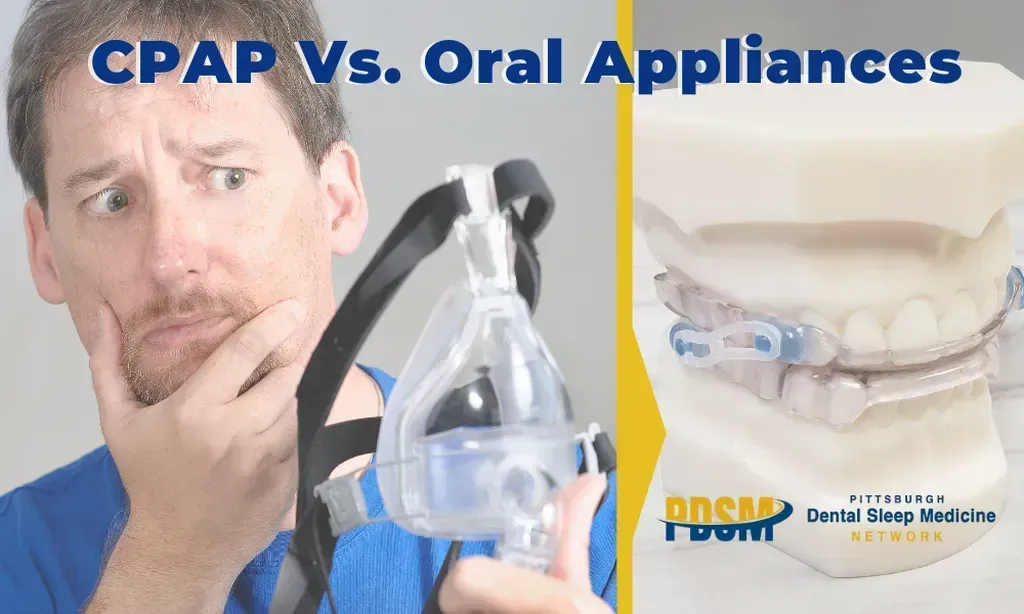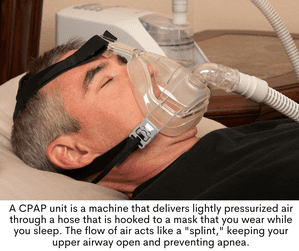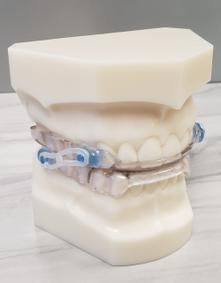CPAP Vs. Oral Appliance Therapy (OAT)

C(ontinuous)P(ositive)A(irway)P(ressure) units are the most commonly prescribed solutions for those who are diagnosed with sleep apnea/snoring. CPAP is a very effective treatment for people who can accommodate to its nightly use but, unfortunately...
C(ontinuous)P(ositive)A(irway)P(ressure) units are the most commonly prescribed solutions for those who are diagnosed with sleep apnea/snoring. CPAP is a very effective treatment for people who can accommodate to its nightly use but, unfortunately, it does not work for everyone. When someone reports the inability to use CPAP, their physician or dentist may recommend an oral appliance.
Studies show that, despite the highly effective treatment CPAP offers, poor adherence limits its efficacy. Compliance has been variably classified in the literature and thus adherence rates range from 40–85% (1,15). In the US, compliance has been arbitrarily defined as using for more than 4 hours per night for more than 70% of nights.
www.https://www.ncbi.nlm.nih.gov

Dental Appliances For Sleep Apnea
Oral appliances are a first-line treatment for people diagnosed with mild or moderate sleep apnea. People diagnosed with severe sleep apnea, who for some reason cannot tolerate CPAP, also become candidates for oral appliance use.
Sleep apnea is diagnosed using a tool called a sleep study. Sleep studies are done both in a sleep lab and at home. Which one is prescribed for you will depend on the judgment of your physician. To qualify as a candidate for oral appliance use a sleep study followed by a diagnosis of mild, moderate, or severe sleep apnea is required.

Oral appliances for sleep apnea treatment resemble orthodontic appliances. Trays will fit snuggly on upper and lower teeth and they will be connected by some form of attachment. The goal of appliance use is to hold the jaw stable, not allowing it to fall back giving the tongue or other structures a chance to initiate airway collapse during sleep.
Oral appliances made in a dental office are fully adjustable. This is a big advantage over appliances that can be purchased in a pharmacy or online. A custom fit allows the dentist to precisely fit the appliance as well as gain the flexibility to try different settings (jaw positions) until the setting that creates the most benefit is found. Some examples of appliances used in the treatment of sleep apnea can be seen below.
When oral appliances are prescribed it makes sense to find a dentist who is specially trained in the use of oral appliances in the treatment of sleep-related problems. At Pennsylvania Dental Sleep Medicine, Dr. Becky Fox has achieved Diplomate status through the American Board of Dental Sleep Medicine. OAT is covered by most medical insurance plans.
CPAP's Long and Complicated History
CPAP units function by providing air, under pressure, through tubing that leads to a mask over the entire face, or just the nose and mouth or nasal inserts. The constant air pressure holds the airway open all night during sleep thereby preventing airway collapse.
CPAP has a long and complicated history related to its use. It has been in common use to help solve sleep apnea issues for about 35 years. From the beginning, it has been shown to be the most effective tool in the arsenal of solutions for sleep apnea. However, patient groups were divided early on into those who adapted easily to CPAP use and those who simply could not use it, for many reasons. Those reasons include but are not limited to the inability to find a comfortable mask fit, mask leakage of air, too noisy for sleep partners, too much trouble to maintain on a daily basis, recurrent sinus problems, and claustrophobia.
CPAP intolerance drove the need for an alternative solution to sleep apnea issues that has led to the development and widespread use of oral appliance therapy.
Conclusions:
Given the risks that come with untreated sleep apnea such as cardiac-related problems, high blood pressure, and hormone-related issues like diabetes, treatment is essential. Which treatment is selected will depend on a host of factors including the severity of the apnea, tolerance or intolerance of CPAP, anatomical considerations, and physician preference.
Each treatment choice has pluses and minuses. Be sure to fully discuss the options, benefits, and shortcomings of each, with your medical and dental professionals when considering treatment for sleep apnea.
How do I know if an oral appliance is right for me?
There are many different types of oral appliances to choose from. Having that range of choices is a great way to find a device that suits your needs, but the sheer volume of available options can be intimidating.
Some of the oral appliances preferred by the team at Pittsburgh Dental Sleep Medicine include:
- HerbstⓇ Advance
- Elastomeric Mandibular Advancement
- TAPⓇ 3
- Panthera Sleep D-SAD
- ProSomnusⓇ MicrO2
- WholeYou™ Respire Pink
- Medley Appliances
- 3D-Avant
Dr. Becky Fox, at Pennsylvania Dental Sleep Medicine, performs a thorough diagnostic exam prior to suggesting oral appliance options. Your practitioner also works with your extended medical team to understand the full scope of your needs. This approach helps you find a CPAP alternative that works for you without an extensive period of trial and error.
Sleep plays an essential role in every aspect of your life. The faster you’re able to find a solution that helps you get the rest you need, the sooner you notice the improvements in your health and wellness that come with quality sleep.
When you’re ready, book a one-on-one consultation at
Pennsylvania Dental Sleep Medicine. Online scheduling is available, or you’re always welcome to call or stop by the office to check appointment availability.


